Gruver: The greatest World Series never played
By Ed Gruver
Murderers’ Row and the Gashouse Gang. The M&M Boys and El Birdos.
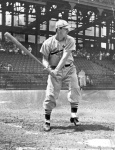 The New York Yankees and St. Louis Cardinals have fielded some of the greatest and most colorful teams in World Series history. Five times they’ve collided in the Fall Classic; twice their Series went the full seven games.
The New York Yankees and St. Louis Cardinals have fielded some of the greatest and most colorful teams in World Series history. Five times they’ve collided in the Fall Classic; twice their Series went the full seven games.
Their meetings have been rare — the last Yankees-Cardinals World Series came in 1964 — but when the stars aligned overhead, they also aligned on the field. In 1926 and again in ’28 sluggers Babe Ruth and Lou Gehrig dug in against wily old Grover Cleveland Alexander; Joe DiMaggio dueled Stan Musial in 1942 (and the Yanks beat the Cards again with DiMaggio in the service in ’43); in 1964 Bob Gibson glared in at Mickey Mantle and Roger Maris while Whitey Ford pitched low and away to Lou Brock and Curt Flood.
Yet as memorable as those October matchups were, the most intriguing may be the ones that didn’t happen. Two of these franchise’s more famous clubs — the Depression-era Bronx Bombers and the Cardinals’ Gashouse Gang — came close to clashing in 1934 and again in ’36 only to be thwarted by the baseball gods.
When the Gashouse Gang of Dizzy Dean, Pepper Martin, Ducky Medwick, Daffy Dean, Leo “The Lip” Durocher, and Frankie Frisch fought their way to the National League pennant in 1934, the Bronx Bombers of Ruth, Gehrig, Tony Lazzeri, Lefty Gomez, and Bill Dickey finished second in the AL.
Two years later, the Yankees had added a young DiMaggio to go with Gehrig, Gomez, Dickey, et al. and the Bombers blew away the American League, finishing 19½ games ahead of second-place Detroit. The Yankees appeared to be on a collision course with the Cardinals, who benefiting from the addition of Big Cat Johnny Mize, spent a good deal of the summer — 91 days — in first place in the NL.
With the likelihood of the Cards capturing the flag, an October showdown between two of baseball’s legendary clubs appeared to be in the offing.
The annual Midsummer Classic provided a preview of what looked to come. Standing on the hill at Braves Field in Boston on the afternoon of July 7 was Dizzy Dean. DiMaggio and Gehrig batted third and fourth, respectively, for the AL. Joe D. and Diz posed for photographers on the field prior to the game, and in the first inning the Cardinal ace, firing his high hard one — the “Dean Special” — got the Yankee Clipper to ground into an inning-ending double play.
Gehrig walked to start the second and the Iron Horse took up residence at first base with his opposite, the Redbirds’ Ripper Collins. With two outs, Gehrig, still at first, was picked off by Dean, his Gashouse Gang teammate Collins applying the tag.
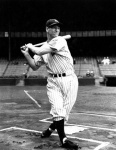 Dean departed after three innings but with a 2-0 lead, the NL stars having reached Red Sox flamethrower Lefty Grove for a pair of runs in the second. Dean earned the win, pitching hitless ball while walking two and striking out three.
Dean departed after three innings but with a 2-0 lead, the NL stars having reached Red Sox flamethrower Lefty Grove for a pair of runs in the second. Dean earned the win, pitching hitless ball while walking two and striking out three.
Unfortunately for fans at the time and historians of the future, Diz and the Gashousers did not get to oppose the Yankees that October. The fault may lie with St. Louis’ front office. Like other big league clubs at the time, the Cardinals played exhibition games against town teams during the regular season. These were the lean years of the Great Depression and baseball owners saw these exhibitions as a means to making extra money. St. Louis boss Sam Breadon and vice president Branch Rickey knew the Gashouse Gang was not only the most colorful team of its era but also the most popular. They scheduled their Gashousers for a great many exhibition games, often to the chagrin of Cardinal players.
It was not uncommon for the Cards, while on an East Coast swing, to play a town team in Metuchen, New Jersey, on a steamy July night and then make their way by train to New York City and be up the next morning to face screwball artist Carl Hubbell and the rival Giants in an early afternoon game.
Durocher recalled in his autobiography, Nice Guys Finish Last, Cardinals’ exhibition games in small towns in the middle of the pennant race. Dizzy and Pepper would stand on Main Street and drum up interest by announcing the arrival of the Gashouse Gang. The famous Gashousers would pack the stands but schedules like this undoubtedly took a toll on the team, even one as resilient as the Redbirds. In 1936 it may have cost the Cards another pennant and a date with the Yankees in the World Series. St. Louis was in first place as late as August 24 but faded in the final month and finished five games behind the Giants.
How Diz, Pepper, and the roguish Gashousers would have dealt with DiMaggio, Gehrig, and the lordly Yankees in a Fall Classic that October is difficult to say given the sample size of their on-field meetings is small and limited to All-Star games.
Cardinal stars Martin, Medwick, and Collins hit against Yankees ace Lefty Gomez in the 1935 All-Star Game. Unlike today when All-Star starting pitchers are limited to two or three innings, Gomez worked six for manager Mickey Cochrane. Martin led off in front of a Cleveland Stadium crowd of 69,812 on that July 8 afternoon with a single. Despite being held on by Gehrig and Gomez, the Wild Horse of the Osage stole second. He was stranded when Gomez struck out Medwick to end the inning.
Gomez clamped down on the big guns of the Gashouse Gang offense. He fanned Martin in the third and again in the fifth, walked Medwick in the fourth and induced Ducky to fly to right in the sixth.
Gomez and Dean dueled as starters in the 1937 All-Star Game, played July 7 in Washington’s Griffith Stadium. Medwick and Mize were the Gashousers in the NL’s starting lineup; Bronx Bombers Gehrig, DiMaggio, Dickey, and Red Rolfe started for the AL.
Gomez got Medwick to ground into a force play to end a potential rally in the top of the first. Dean took the mound in the bottom of the inning and induced Rolfe to hit an unassisted groundout to Mize at first. DiMaggio worked Diz for a two-out walk, prompting AL star Al Simmons, who had taken up residence near President Franklin Roosevelt’s box seats, to goad Dean.
“Pitch, you bush leaguer! You’re in the big leagues now!”
Dean responded by striking out Gehrig swinging with a fast curve.
In the dugout, the Iron Horse seemed dismissive of Dean. “He’s not so tough,” Gehrig said between drags on a cigarette. That morning, Gehrig and his wife Eleanor had breakfast with New York sportswriter and friend Fred Lieb. Diz, the self-proclaimed greatest pitcher in baseball, had boasted the AL stars would fall prey to his incomparable “fog ball.” It was the “ol’ No. 1,” the “Dean Special,” a fastball “hot as bacon grease.”
“I don’t know about that,” Gehrig said with a laugh. “Don’t be surprised if I knock one out of the lot against Diz.”
Lou had told Eleanor that morning he felt “like a million dollars.” Lieb looked at Gehrig and thought the Iron Horse looked “as strong as a slab of New Hampshire granite.”
Gomez, tall and lean with a high leg kick, blazing fastball and sweeping curve, retired Mize in the second inning on a fly to left. Dean yielded an infield single to Dickey before fanning his fellow future Hall of Fame mound opponent. Gomez returned the favor in the top of the third, getting Dean to fly to right. Mixing fastballs with a big curve, Dean retired Rolfe on a grounder to short to start the third, but DiMaggio drilled a two-out single to center to keep the inning alive. Up stepped Gehrig.
The Yankee slugger worked the count full and crushed the payoff pitch — Dean’s “ol’ No. 1” — over the right field wall.
“A fastball, right over the middle of the plate,” Gehrig told newsmen afterward. As he crossed home plate, a grinning Gehrig waved his cap at a smiling FDR. Years later Gehrig said his All-Star homer off Dean meant as much to him as his clout off Giants’ ace Carl Hubbell in the ’36 Series.
Gehrig’s blast gave the AL a lead in an eventual 8-3 victory. Gomez outdueled Dean, the Yankee southpaw surrendering just one hit in his three innings of work. The Cardinal right-hander, meanwhile, scattered four hits, walked one and whiffed two.
The ’37 All-Star game was a turning point in Dean’s career. Following Gehrig’s homer, Diz took a line drive off his left cleat by Cleveland’s Earl Averill. The hard-hit ball fractured Dean’s big toe. Trying to return from the injury too soon, Diz strained his famed pitching arm by favoring his foot. Altering his motion and not pushing off his foot as he normally would have, Dean stressed his shoulder. He was just 26 years old, but the injury marked the beginning of the end of his Hall of Fame career.
Diz would have one more encounter with the Yankees, though not as a member of the Cardinals. Shipped to the Chicago Cubs in 1938, Dean went 7-1 in the pennant drive as a spot starter. No longer heaving the high hard one that had led to 30 wins in 1934 and 102 victories from 1933-36, Dean nevertheless got the call to start Game Two of the World Series against the Yankees in Wrigley Field.
Before a packed house of more than 42,000 Dean climbed the hill at Wrigley Field to face a fearsome Yankee squad boasting Gehrig, DiMaggio, Dickey, Rolfe, Frankie Crosetti, Tommy Henrich, et al. Dean could look to his left and see a familiar face at first base, his old Gashouse Gang teammate Rip Collins.
Dean could see another familiar face in the man taking the mound for New York — former All-Star foe Gomez.
Amid a brilliant sunshine that bathed the playing field and dramatic mid-October shadows that slanted across home plate, Dean pitched gritty, gutsy baseball. Diz’s sore arm dictated he battle the Yankees with slow stuff, but at times he mustered his country hardball and blew hard strikes past the Bronx Bombers.
Gomez allowed a run in the first but Dean surrendered the slim lead in the second. DiMaggio pulled a single to left to lead off the inning and Gehrig walked. Dean retired Dickey and George Selkirk before Joe Gordon stroked a two-run double to left. “A freak double,” radio announcer John Harrington said, noting that third baseman Stan Hack and shortstop Billy Jurges collided as they converged on what should have been an easy out.
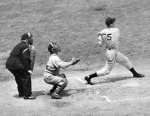 The Cubs reclaimed the lead with a pair of runs off Gomez in the third. Dean, changing speeds and pitching with guile, deceived the Yankees by throwing his off-speed pitches with the same motion he used when he muscled up on his fastball. Dean’s second-inning offering to DiMaggio had such little spin Harrington said he could see the stitches on the ball. Harrington told listeners Diz was just “oozing” the ball in there.
The Cubs reclaimed the lead with a pair of runs off Gomez in the third. Dean, changing speeds and pitching with guile, deceived the Yankees by throwing his off-speed pitches with the same motion he used when he muscled up on his fastball. Dean’s second-inning offering to DiMaggio had such little spin Harrington said he could see the stitches on the ball. Harrington told listeners Diz was just “oozing” the ball in there.
In the fourth inning Dean delivered an inside pitch to Gehrig that was so slow the Iron Horse stepped back and grinned. The two stars then engaged in gamesmanship. Dean was working fast to keep his ailing arm warm, so Gehrig sought to break his rhythm by stepping out of the box four times in the at-bat. Dean grew angry and made Gehrig wait by stepping off the mound to grab the rosin bag. Lou lined the next pitch off Collins for a single.
In the long history of the World Series, Dean’s emotion-packed performance in Game Two was one for the ages. Watching Diz stymie the Yankees’ strongmen with a series of sidearm curves, radio announcer Pat Flanagan called it “a spectacular ballgame.” This was a great but vulnerable pitcher near the end of his career trying to hold off a team of ferocious sluggers on the game’s grandest stage. The ’38 Yankees were a 966-run juggernaut that featured four future Hall of Famers in their lineup: Gehrig, DiMaggio, Dickey and Gordon. Dean in ’38 was like Walter Johnson in Game Seven of the 1924 World Series; Catfish Hunter battling the Big Red Machine in 1976; Pedro Martinez in 2009, reviving a personal rivalry with the Yankees.
To Cubs catcher and skipper Gabby Hartnett, Dean’s dramatic performance stirred memories of Diz’s dazzling defeat of Pittsburgh on September 27 on the same Wrigley mound. Facing the first-place Pirates and trailing by a game-and-a-half with seven games remaining in the regular season, Dean allowed the famed Waner Brothers — Lloyd and Paul — and .300 hitters Johnny Rizzo and Arky Vaughn one run in 8? innings.
Diz hadn’t pitched since September 13 and hadn’t started since August 12. “But how he pitched!” Hartnett once recalled. “Just a slow ball, control, and a world of heart.”
Dean didn’t strike out a single batter that day against the Pirates but he didn’t walk one either, and he hurled the Cubs to a 2-1 win that pulled hard-charging Chicago to within a half-game of Pittsburgh in the furious pennant race. The Cubs would take the lead in the National League the next day and hold it the rest of the way.
Hartnett said Dean never complained that he’d lost his stuff or that his arm was throbbing. Diz could pitch great for five innings, as he did that afternoon against Pittsburgh, then Hartnett would notice that Dean would tire and he wouldn’t have as much on the ball. Hartnett had coaxed Dean into the ninth inning against the Bucs but the Bombers were another story. Still, Hartnett was hoping the Ol’ Master could muster one more magical outing against the powerful American League champions.
The big crowd at Wrigley Field for Game Two knew Dean was dealing against a stacked deck. The Yankees were aiming for an unprecedented third straight World Series title and sixth since 1927. In that time they were 21-3 against NL competition. The staggering odds against him made Dean’s performance more gripping, more fascinating. When Diz came to bat in the fourth inning he received as big a hand from Yankees followers as Cubs fans. When Dean singled off Gomez Wrigley Field was filled with tremendous applause. In the sixth, Diz’s first strikeout of the game elicited an enormous roar.
The crowd, into the game from the start, hung on every pitch as Dean delivered an assortment of sidearm curves and sidearm fastballs. As he walked from the mound at the end of the sixth, thousands of fans rose and gave the Ol’ Master a standing ovation. Harrington noted in the seventh that it was still a “beautiful, bright, sunshiny day” on Chicago’s North Side. The Great Dean added to the atmosphere by retiring DiMaggio, Gehrig and Dickey in order on just nine pitches, bringing Cubs’ fans to their feet yet again.
Ol’ Diz was four outs away from a historic — Homeric, even — victory when Crosetti stepped in. It was noted on the radio broadcast that the Yankees shortstop had been hitting the ball hard all afternoon. Pitching deliberately and issuing offerings that were described on the radio as “very slow,” Dean worked the count to 3-2. Cubs fans in the stands and watching from surrounding rooftops pleaded for the inning-ending out. Presaging the dramatic postseason homer that would be hit by a light-hitting Yankees shortstop — Bucky Dent — 50 years later, Crosetti cracked a two-out, two-run homer to regain the lead for New York. Dean headed back to the hill in the ninth, but the Yankees ended his day as Henrich stroked a leadoff single and DiMaggio pulled a homer deep to left.
Reporters lauded the Great Dean’s grit. On the front sports page of the Los Angeles Times Henry McLemore wrote that Diz strode from the mound just as he had burst into the big leagues years before — “proud, swaggering, courageous and unwilling to yield and inch until a better man made him yield it.”
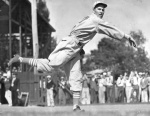 Fans in Wrigley Field, McLemore wrote, had watched “one of the greatest exhibitions of heart and head and competitive spirit in the history of baseball”:
Fans in Wrigley Field, McLemore wrote, had watched “one of the greatest exhibitions of heart and head and competitive spirit in the history of baseball”:
“Thrown out against the Yankees, the murderers of baseball, Dean held them for seven innings. Patiently, carefully, shrewdly and courageously, inch by inch, he snuffed the fuse of the Yankee bomb. Time and again it seemed as if the flame must lick by his fingers to run sputteringly to the powder charge that has littered so many ball fields with casualties.
“But he managed to snuff it. Lord knows what with! He didn’t have anything but a change of pace.”
Diz made one more appearance in the ’38 Series, taking his first trip ever to the Yankee Stadium mound late in Game Four. Coming on in relief in the eighth inning of what would be the final game, Dean gave up a two-run double to Crosetti, the Crow again feasting on Diz’s deliveries. Dean avoided further damage by retiring Rolfe on a liner to Collins for the third out.
Dean in 1938 was not only climbing the hillocks on the game’s grandest stage, he was also climbing the hill all living beings climb, the one that sees green shoots turn into withered stalks. It was the same hill Babe Ruth had climbed just three years earlier when the Bambino’s career intersected with Diz’s in 1935.
Dean pitched against an aging Ruth that season, the Babe playing with the Boston Braves following his release by the Yankees. On March 20 the Cardinals set a spring training record when 6,467 crowded into a St. Petersburg ballpark to watch Dean duel Ruth. In his only at bat against Diz that day, the Babe scraped the Florida sky with a towering fly out. Ruth then drilled two doubles into the overflow crowd against Dean’s successors.
On May 5, Dean and Ruth met again, the superstar showmen drawing 30,000 to Braves Field for their showdown. Ruth worked walks from Dean his first two times up. When the Bambino came up again Diz got two strikes on him and, relishing the moment, issued a big grin as he waved his outfielders back. Dean then whistled a fastball past the 40-year-old Sultan of Swat for strike three. Ruth, according to one account, was nearly “breaking his back” trying to catch up to Dean’s heater. Dean won 7-0 and helped his own cause by homering over Ruth’s head in right field. Two weeks later, Dean held Ruth hitless again in another Cardinals’ victory.
Baseball’s two greatest showmen had nearly faced one another a year earlier in the 1934 All-Star Game. Ruth played the first 4½ innings before being replaced by Yankee teammate Ben Chapman. Dean came on in the sixth and worked three innings. Facing Yankee stars Dickey, Chapman, and Gehrig, Dean walked Dickey in the sixth and surrendered a two-out triple to Chapman in the seventh but stranded him by striking out Gehrig.
Had the Yankees and Cardinals met in ’34, their stars would have been familiar with each other thanks to the newly created All-Star Game. Ruth had christened the first Midsummer Classic in 1933 when he hooked his big bat into an offering by the Cardinals’ Bill Hallahan in the third inning for the first home run in All-Star competition.
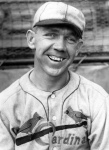 Hallahan, considered a clutch hurler for his two wins over the favored Philadelphia Athletics in the 1931 Fall Classic, started strong against the Yankee contingent of Chapman, Ruth, and Gehrig in the first inning, not allowing any of the three to hit the ball out of the infield and fanning Ruth looking. He gave up a single to Gomez in the second but retired Chapman on an inning-ending groundout. After surrendering Ruth’s homer in the third, Hallahan walked Gehrig and was taken out.
Hallahan, considered a clutch hurler for his two wins over the favored Philadelphia Athletics in the 1931 Fall Classic, started strong against the Yankee contingent of Chapman, Ruth, and Gehrig in the first inning, not allowing any of the three to hit the ball out of the infield and fanning Ruth looking. He gave up a single to Gomez in the second but retired Chapman on an inning-ending groundout. After surrendering Ruth’s homer in the third, Hallahan walked Gehrig and was taken out.
Gomez faced two Gashouse Gang members in the ’33 All-Star Game, leadoff man Pepper Martin and 2-hole hitter Frisch, the Cardinals’ second baseman and player/manager. Neither could get the ball out of the infield on Gomez. He retired both on groundouts in the first and got Pepper to pop up to short in the third.
Gomez started for the AL in 1934 and faced Frisch and Medwick. Frisch, leading off the bottom of the first, homered to deep right off Gomez. Medwick struck out but facing Gomez again in the third, hammered a three-run homer to left to give the NL a 4-0 lead. Frisch, who had walked, scored his second run of the day against Gomez.
Yankees right-hander Red Ruffing replaced Gomez and facing Martin and Frisch in the fifth surrendered a walk and single, respectively. Both scored as Ruffing got roughed up for three runs in the inning.
Though meetings of the members of the Bronx Bombers and Gashouse Gang were limited to the Midsummer Classic and not the Fall Classic, their stars were not strangers to one another. Gomez considered Dean the best pitcher in the National League; Dean thought Gomez the best pitcher in baseball — “except me.”
Scrappy Pepper Martin, playing third base for the NL in the ’33 All-Star Game, was a big fan of the Babe’s. After watching Ruth trot past him Martin paid a stadium usher to retrieve the ball. Pepper later took the ball to Ruth to have it signed.
Dean, too, knew all about New York’s pinstripe prestige. He said the Yankees were a team every ball player wanted to wind up his career with. Diz also knew of Ruth’s popularity, telling Rickey, “I’ll put more people in the park than anyone since Babe Ruth.”
In the mid-1930s, Dean had a one-sided rivalry with Ruth. When Babe joined the Boston Braves, Dean slammed Ruth in the newspapers.
Though Frisch believed the Babe would be a great asset to the National League, Diz had a different opinion. “He made all his money in the American League, so why doesn’t he stay there?” Dean huffed.
Dean thought the Junior Circuit inferior to the National League and rarely hesitated to say so. Years later, he had the tables turned on him by another cocky young pitcher, Whitey Ford. After the Yankees beat the Phillies in the first two games of the 1950 World Series in Philadelphia, Ford spotted Dean, then a Yankees broadcaster, sitting in the train station awaiting the trip to New York. Walking up to Diz, Whitey cracked, “Now I know how you won 30 games in this bush league.” The Yankees swept the National League champs in four games, Ford applying the finisher in Game Four at the Stadium.
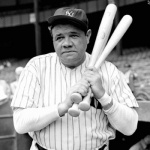 Dean’s strong opinions raised the ire of opposing players. Gehrig respected Diz — “You never know when you’re going to hit a pitcher like Dizzy Dean,” he said following his home run in the ’37 All-Star Game. But Lou’s teammates on the AL squad serenaded the defeated Dean with derisive chants of “Oh, oh, Dizzy Dean, who’s Dizzy now!”
Dean’s strong opinions raised the ire of opposing players. Gehrig respected Diz — “You never know when you’re going to hit a pitcher like Dizzy Dean,” he said following his home run in the ’37 All-Star Game. But Lou’s teammates on the AL squad serenaded the defeated Dean with derisive chants of “Oh, oh, Dizzy Dean, who’s Dizzy now!”
The Yankees were well aware of Dean and the Gashousers’ reputation for rowdiness. Henrich saw Diz, Pepper, Ducky, Leo the Lip, the Big Cat, the Fordham Flash, and the rest of the Gashouse Gang in an exhibition game in New Orleans. “Most of them needed a shave and every one of them had a dirty uniform on. What a bunch of bums,” Henrich thought. “Now this is really the Gashouse Gang.”
Filthy uniforms and five o’clock shadows seemed fitting for a team whose rough and rowdy style of play mirrored their raucous personalities. Durocher, a slick-fielding and combative shortstop who had the honor of playing for both the Murderers’ Row Yankees of the 1926-28 and the Gashouse Gang Cardinals of 1934-38, said in Nice Guys Finish Last that the Cardinals saw baseball as a sort of warfare on the field. The Lip recalled the Cardinals’ uniforms being so caked with dirt and dried mud from head-first dives and take-out slides that they could have thrown them in the corner and they’d have stood upright on their own. The red bills of their cloth caps were creased and bent and twisted. The Gashouse Gang looked horrible, Durocher stated. They knew it and what’s more, The Lip wrote, the Gashousers “gloried in it.”
Outfielder Enos Slaughter, who joined the Cardinals in 1938, thought it typical for the Gashouse Gang to have dust-ups with opponents, particularly the Brooklyn Dodgers. If two or three batters weren’t decked or drilled by a pitch then it wasn’t a typical Cardinals-Dodgers game. As far as Slaughter and the Gashousers were concerned, if a player couldn’t take being knocked down he didn’t belong in the big leagues.
The Cardinals’ brawling brand of ball captured the nation’s attention in the 1934 World Series against Detroit and led to Tiger fans pelting Medwick with so much debris following a Game Seven scuffle that commissioner Kenesaw Mountain Landis ordered Medwick from the game to restore order and prevent a riot. Cardinals infielder Burgess Whitehead thought the Gashouse Gang was the greatest club he ever saw. Pepper Martin personified the club’s hustling ways and when the Gashouse Gang got out on the field, Whitehead said, they played hardball and played it to the hilt. When they slid they slid hard; there was no good fellowship with the other team. They were a fists-first fraternity who looked like hobos from the freight yards, but they were also damn good ball players.
The Gashouse Gang was renowned for country hardball; the Bronx Bombers for their brand of big-city ball. Henrich said manager Joe McCarthy wanted professionalism out of his players and the attitude of his second baseman, Joe Gordon, exemplified that approach. Gordon didn’t know his batting average or fielding average. All Gordon did, McCarthy told reporters, was come to beat you every day.
The Yankees beat the NL’s best in four straight World Series from 1936-39. This was the club that established the Yankees’ corporate image. Where the Gashouse Gang was a team of entertainers – Pepper Martin’s pregame ball juggling act, complete with fakes, feints, misdirection and sleight of hand, was an enormous crowd-pleaser – the Yankees were men of intense sobriety; business-like, no-nonsense.
While Dizzy and Pepper were characters who made the Cardinals colorful, Gehrig established the Yankee image of being serious and all-business on the ball field. When DiMaggio arrived in ’36 he fit perfectly the club’s persona of cool professionalism. It was an image that extended even to their uniforms.
The Yankees’ pinstripes were nothing less than sartorial splendor, a sharp contrast to the ragged outfits that reflected the Gashouse Gang’s riotous ways. Clean and dignified, the pinstripes enhanced the image of the Yankees as businessmen who expected to win and did win. Henrich said his greatest thrill in baseball was putting on the Yankee uniform. He knew, he said, he was with a team of polished professionals.
A Cardinals-Yankees World Series showdown in the mid-Thirties would have had more than the customary amount of story lines and sub plots: The self-proclaimed “Great Dean” throwing high heat — the “ol’ No. 1” — to Ruth, Gehrig, Lazzeri and Dickey in ’34, and Gehrig, DiMaggio, Dickey and Lazzeri in ’36; Gomez and Ruffing versus Martin, Medwick, Mize and Frisch; St. Louis’s swagger against New York’s style; the Gashouse’s Gang’s hustle against the Bronx Bombers’ power; grit and guile opposite polished professionalism; country hardball versus big-city ball.
It would have been a classic Fall Classic. Instead, it’s the greatest World Series never played.
SABR member ED GRUVER has been a sportswriter for Pennsylvania dailies for 30 years and has covered the Philadelphia Phillies and Baltimore Orioles as a columnist. He has written six books, including two on baseball, “Koufax” (2000) and “Hairs Versus Squares: The Mustache Gang, Big Red Machine and Tumultuous Summer of ’72.” (due out in 2015).
Originally published: October 15, 2014. Last Updated: October 15, 2014.


